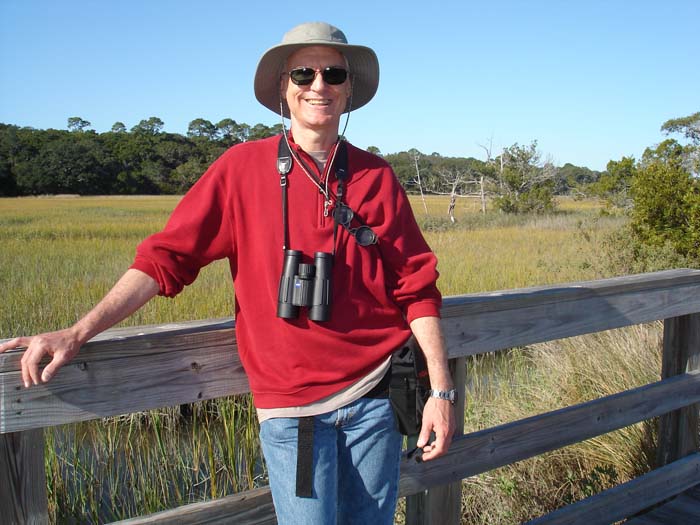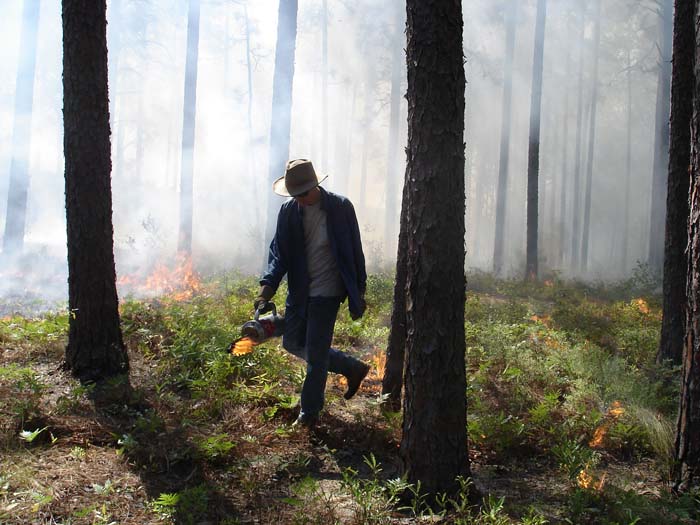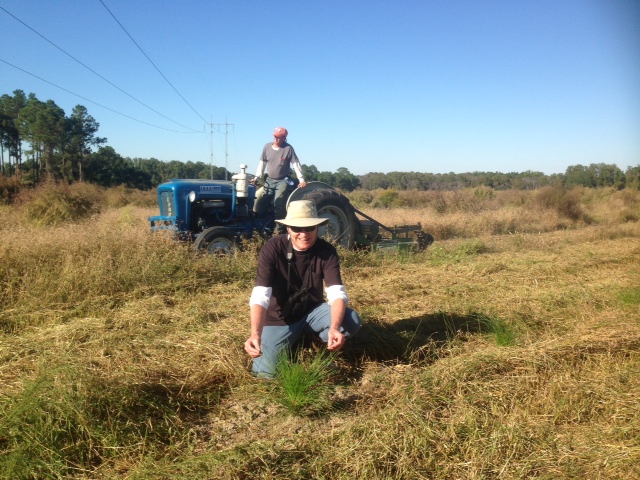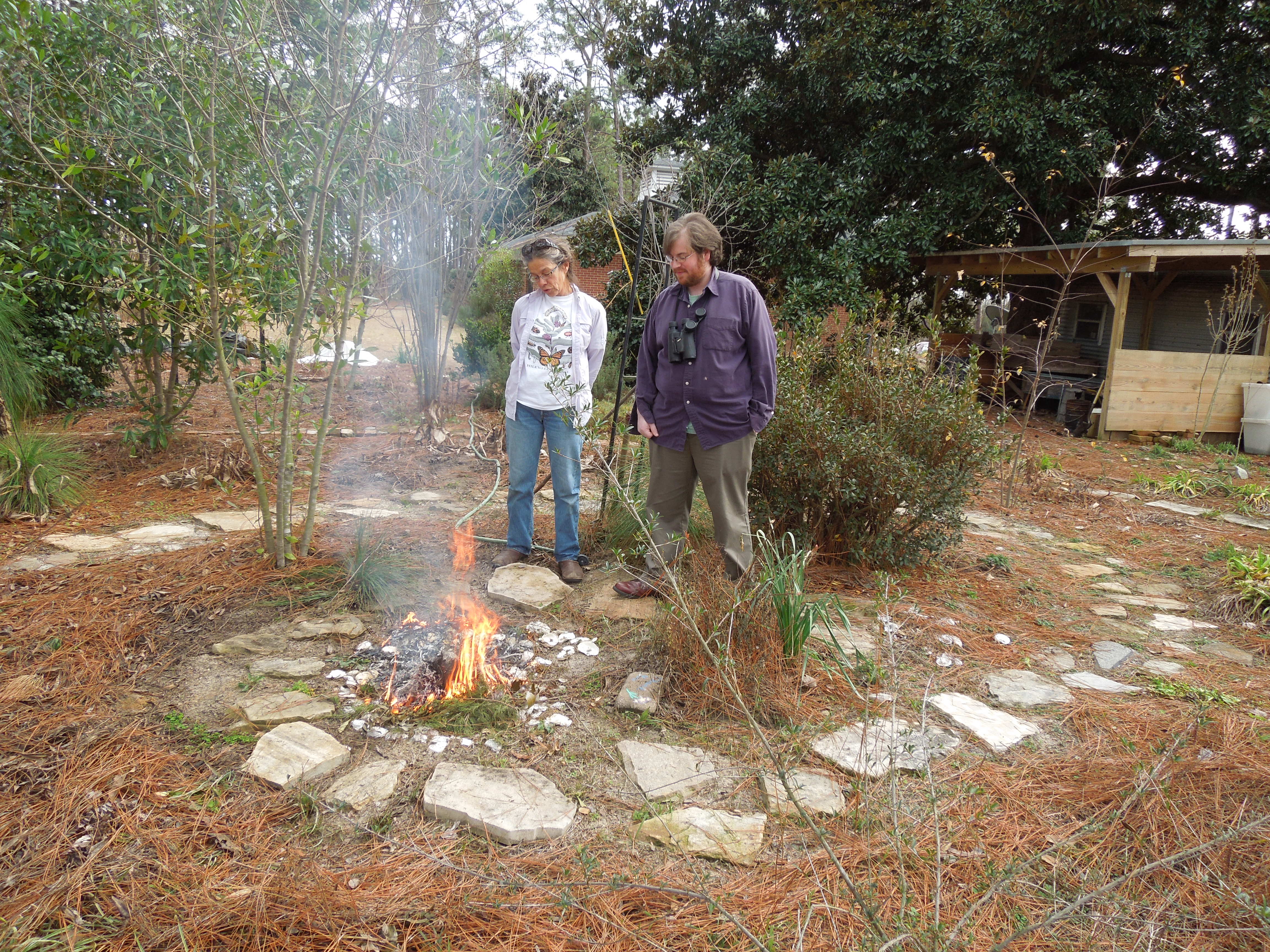
Interview with Featured Poet
Daniel Corrie

[Town Creek Poetry] I’ll start off by summarizing some key points about you as a poet and a man. Your poetry has two thematic preoccupations: time and the natural world. Your poetry ranges from free verse to strict formalist rhyme and meter, with many hybrid poems along this continuum. You’ve been postponing publishing your book for a remarkably long time, to continue working on it. You’ve been carrying out ecological restoration and wildlife management on your South Georgia farm. You’ve been an eco activist who devoted a year of your life to fighting a proposed coal-fired power plant. [Daniel Corrie] Yes. [TCP] Why is so much of your poetry ecological? [DC] I’m an Earth poet or eco poet for many reasons. One reason is nature amazes me. Also I believe the most significant art might serve as humankind’s collective Big Dream guiding us to better awareness of our place within our world that our species is severely stressing. Clearly, human patterns of activity are destroying long-evolved living beauty and our own life-support systems. I’ve been surprised that so much poetry continues to be written that doesn’t acknowledge these urgencies that define our time. [TCP] So you believe art might be transformative. I don’t find your poetry to be didactic. Can you describe how poetry avoids becoming didactic while influencing readers to change? [DC] Such art doesn’t have to be propaganda. Our dreamlife isn’t didactic, but it affects us profoundly. I think art can work like that. [TCP] Ecology for you is more than a source of subject matter for your poetry. You’ve taken action based on your environmentalist values. Summarize your successful fight against a coal plant proposed for South Georgia. [DC] I know you agree with me that writing can be a significant act – a means of authentically acting on one’s values. But, yes, I’ve been a reluctant activist. In 2008, news leaked that 3,600 acres had been quietly bought up to be the site of a proposed coal-powered electrical plant. The site was near our farm – only two counties away. Long concerned about climate change, my wife and I felt we were being faced with a situation requiring us to step up. Ellen and I, along with two friends, organized a grassroots group to oppose the coal plant. I ended up volunteering a very intense year’s full-time commitment to that project. I wrote grant applications to bring in $25,000 from the Rockefeller Family Fund to help with the fight. Our group regularly bought space in the local newspaper, organized community meetings and brought in speakers to help county voters understand why the coal plant developer’s promises of jobs and local prosperity were greatly overstated while long-term health impacts were very real. The most important contribution our group made was to discover the purchased land had not yet been rezoned from agricultural to industrial, and we organized residents near the proposed site to join in working with an environmental law firm to sue the county if its county commission attempted to rezone the land. Our group also coordinated closely with state and national environmental groups that were able to use that leverage of the threatened law suit and the local show of opposition as part of their strategy in obtaining an agreement to cancel the coal plant. It was a very happy day when that news broke. I was glad to return to thinking about poetry.  [TCP] Too, your love and concern for the natural world extends beyond your work as a poet. I’ve been a guest at your Longleaf Dharma Farm in Tift County, Georgia. Describe some of Ellen’s and your work there. [DC] Around 2007, my wife and I began a process of relocating from Atlanta to take over her inherited family farm. We continue to rent about half of the land to neighboring farmers to help with taxes and upkeep. We’ve been working to convert the other half with the goals of wildlife management and ecological restoration. When we took over the farm, 80 acres were overgrown with 25-year-old planted slash pine, a tree crop so dense that the stands were a biological desert for wildlife and understory flora. We thinned the parcels to a density hospitable to wildlife, leaving the best trees intact. Also we introduced prescribed burning to the parcels, which has stimulated the growth of dormant, suppressed native understory. Even in this short time, we’ve seen a significant rejuvenation of wildlife, especially in the surprisingly strong increase in gopher tortoises. The gopher tortoise is a keystone species with its burrows supporting numerous additional native fauna. We’ve also converted 60 acres from cotton fields by planting longleaf pine seedlings and native understory flora. At the time of first European contact, longleaf-pine ecosystem covered 60 percent of my native South. Due to human impacts, 98 percent of it has been lost. This decline is among the most severe of any ecosystem on earth. What Ellen and I are doing is small, but it helps a little, and we love seeing more wildlife finding a home or a hospitable stopover here – chats, shrikes, red-headed woodpeckers, pileateds, brown-headed nuthatches, great-crested flycatchers, blue grosbeaks, indigo buntings, kestrels, meadowlarks, woodstorks. One day I looked down to the pond and saw a bobcat running beside it. We’re also deeply fortunate to have our inherited house situated within a 12-acre remnant site of mature longleaf pine and intact native understory, which Ellen and I burn every couple of years to rejuvenate it. The farm is our little corner of the biosphere we’re trying to help along.  [TCP] Will the farm be your and Ellen’s home for the rest of your lives? [DC] This is an experiment for us, loving being on the farm and seeing if rural culture will be sufficiently sustaining for us at this point in our lives. I have a neighboring fellow eco writer in our dear friend Janisse Ray, who lives on her and her husband’s Red Earth Farm a couple of hours from us. We four and other friends scheme about a rural counterculture finding fruition down here in South Georgia. Neither Ellen nor I would want to paint a picture of an idealized agrarian life, but also the agrarian life offers a great deal that we cherish. I named our farm Longleaf Dharma Farm as a means of helping to focus my thoughts and energies in being here. [TCP] More poets are gravitating to writing eco poetry, but your stylistic range is noteworthy. Quite a lot of eco poetry is written in free verse. While much of your poetry is free verse, you’ve published metered poetry, rhymed poetry and poetry in given forms like terza rima and villanelles. A villanelle of yours received the 2011 Morton Marr Prize. Both your free verse and formal verse can be very sensually sonic. [DC] While there is a clear continuity in my poems’ concerns and sensibilities, I like to think I haven’t tended to repeat myself. I’ve wanted to keep searching for different forms and approaches, without resorting to empty gimmickry. [TCP] Much eco poetry can be very concrete and literal, while yours deliberately engages the imagination. [DC] As far as eco poetry goes, there has been a strong tradition of the plainspoken green poem. Gary Snyder is an American icon of this mode of poetry, with his influential Zen aesthetic sense. I personally love well-written poetry of this type that might be understood as a literary counterpart to the green lifestyle of voluntary simplicity. This sort of poetry might be called “green plainsong,” though that descriptor might be prosodically misleading since this poetry doesn’t explore sonics very actively, perhaps in part because of many green poets’ general instinct away from anything that might feel for them like inauthentic ornamentation. While I admire successful examples of plainspoken nature poetry and eco poetry, I also believe authenticity can be accessed and amplified through artistic stylization. Though always valuing clarity of expression, I tend to be drawn to the other end of this literary continuum or spectrum, toward what I think of as “imaginal green poetry.” While I’m drawn to write imaginal poetry, I work at ensuring my poetry’s essence is true to the world at hand – that my poetry isn’t imaginary.
[TCP] How does the “imaginal” and artistic stylization relate to environmentalism? [DC] From its beginnings, visual art has been stylized rather than photographically realistic, as with the four dramatic horse heads painted 30,000 years ago in the Chauvet Cave. Though I work to try to have an accurate understanding of nature’s particulars and of broad-scale realities such as climate change and species extinctions, my poetry tends to be more archetypal than realistic. I think there’s a lot to mull over with this. Well before the word ecology came into use, Jung speculated about the human species having a collective unconscious. Jung and his followers tended to be human-centered as they looked for archetypal images, symbols and patterns within human culture, turning to such sources as German fairy tales and Greek myths. By the final decades of the twentieth century, ecopsychologists emerged to begin reexamining the psyche within an ecological-evolutionary framework. In 1992, Theodore Roszak published The Voice of the Earth in which he extended Jung’s “collective unconscious” back into deeper time’s pre-human “ecological unconscious,” as he called it. Such speculations as Roszak’s are examples of our species trying to reconnect ourselves with the natural world with which we co-evolved and within which our species is challenged to learn to co-exist sustainably and meaningfully. The deep imagination – which perhaps is related to Roszak’s ecological unconscious – can be the vibrant source of the bio-mythological vision. [TCP] There is a pervasive sense to your poetry that might be called “spiritual.” How do you characterize this dimension of your poetry? [DC] Sometimes I think the word existential is more for our time than the word spiritual. The word spiritual can be problematic, by implication seeming to privilege invisible spirit over the visible world. More Christian churches are recognizing our time’s environmental issues are urgent moral issues, and I have a kindred feeling and admiration for Christians pursuing creation care. Personally, I’m not theistically or otherworldly oriented. I understand reality through the ecological-evolutionary framework. Yet if we reject all that the word spiritual might mean, life and the world for me feel diminished. Science and technology are crucial for finding our way to a more sustainable collective path. Too, I cherish my green friends who are concerned with practical lifestyle issues, such as reducing their carbon footprints, growing their own food, and so forth. Ellen and I work at doing such things, too. But while I feel kinship with and admire such practicality, I personally feel a need for a larger, fuller context. [TCP] Twentieth-century philosophy brought skepticism to bear on the “larger, fuller context.” You show that sort of deconstructive skepticism in your discomfort with the word spiritual, though you say you’re attracted to some of that word’s meanings. So for our time, what might be a valid way of thinking about some of the meanings of spiritual and existential? [DC] With this, I owe a great debt to Ursula Goodenough’s The Sacred Depths of Nature. Dr. Goodenough is a cell biologist who believes that humans in the course of our development evolved what she calls “religious emotions.” A self-described “non-theist,” she cherishes her own religious emotions, such as the awe she felt as a girl camping out, contemplating the stars and the night sky’s cosmic distances − and the wonder she continues to feel when gazing into a microscope at the complex orderings of cellular life. This is the existential emotional sense that informs my poetry. [TCP] So we’ve discussed your poetry’s ecological preoccupation. Your poetry’s other thematic preoccupation is time. I’ve been in your study and seen your many books on time. The Hudson Review featured an essay of yours about the nature of time. Your poetry goes beyond offering on-the-fly impressions of time. You’ve devoted a great deal of systematic effort to reading and thinking about it. [DC] For example, I’ve been helped in understanding time through my many years as a member of the International Society for the Study of Time. The ISST’s founder, the late philosopher J. T. Fraser, was particularly helpful. I regret he didn’t live until my book was published, to be able to read it. I was honored that he included one of my time poems in his final book.
[TCP] Why is time such an insistent concern for your poetry? [DC] Time and place are life’s existential and moral arena. That’s why in writing about time, Heidegger described each of us as being thrown into the world. The motto of the National Association of Watch and Clock Collectors is, “Time rules life.” Yet an understanding of time is elusive. St. Augustine famously wrote that he thought he knew what time was until he tried to describe it. On a given day, time might feel as gentle as sunlight we enjoy sitting in, but time soon powerfully and destructively accumulates for anything time holds. The more we try to describe time, the more likely we are to speak in koans: for instance, the moment of now is the hinge of time’s departing into emergence. Buddhism’s central truth is that all is ephemeral, and science’s recognition of the law of entropy offers the same insight. How might we decide or learn to pass through time’s dissolutions, especially when our own species is amplifying our current time’s dissolutions as we undermine our planet’s present and future possibilities? [TCP] You’re 59 years old and haven’t published a book. What’s behind that? [DC] My in-progress manuscript several times was selected as a finalist in the Yale and Whitman Competitions. After turning 40, I left a writing/editing job at an institute that had been so demanding I hadn’t been able to think meaningfully about poetry for five years. Finally with some more freedom to return to poetry, I reassessed my manuscript, and it seemed to me a jumble with some scattered promising moments. Year by year, I continued postponing submitting it to a publisher. The more I worked on it, the more I felt I needed more time to let my best poetry find its way to becoming more essentialized and significant. So beyond life’s inevitable distractions, I’ve been a very slow writer − the opposite of prolific. In this process of ongoing postponement, I came to have a guiding urge: to write less and say more. I didn’t realize the lengths I’d go with that. Fortunately for my book, I thus far haven’t died. I haven’t predeceased my manuscript. [TCP] Will you ever finish your book? [DC] My manuscript is long enough to fill two books of the length of a typical poetry collection. As I’ve continued to work on the manuscript for so long, the poems have become interconnected, echoing back and forth between one another. Rather than being a collection of poems, each poem is more like a separate facet of one book-length poem. I think its time is near. [TCP] What constitutes a significant poem? [DC] As time is metamorphosis, so, therefore, is that which constitutes significance. Joanna Macy has called our time the time of the Great Turning. Along these lines, Thomas Berry talked about how our present time must be pivotal, when our species must learn how to move into a new age that he called the Ecozoic Age. Berry wrote about the Great Work, to which people from all walks of life might contribute with their particular efforts and skills, to help humanity shift into the Ecozoic Age. Will we make it? No one knows. But art might have an important role in that striving. Heidegger described us as being thrown into the world, and Eva Brann rhymed that language into a profoundly different self-perception: “We are grown into the world.” The act of writing sometimes becomes a rite. Reading such writing sometimes becomes a rite. I wrote a poem that is a litany of spiral shapes in nature, which inspired my wife to construct a large brick and stone spiral, which is the skeleton for a garden. Her spiral garden is within sight of my desk through my study’s window. It reminds me of a Native American medicine wheel, and walking it has come to feel more and more like the contemplative experience of walking a church labyrinth. Her intentionality feels to have created a locus. On the day of Imbolc, halfway between solstice and equinox, she burns wilted greenery in a pagan tradition, a symbolic rite of warming winter into spring’s rebirth. She’s done this for many years, in our Atlanta home’s back yard and now in the center of the spiral she constructed. This ancient tradition is based on our planet’s natural, astronomical cycles, rather than being a ritual of supernaturalizing or of world transcendence. Brighid is associated with this tradition, who also is associated with poets because, after her son’s death, she invented a type of sung lamentation called keening. Now the Earth is warming too quickly, and poetry might become a new keening. Nature inspired my litany poem that inspired my wife to build her spiral garden that inspires my thoughts in many ways. Energy can seed new and fecund energy. The significant poem might be a source of fructifying influence and confirmation.  [TCP] You use the word authentic. Heidegger wrote about the importance of being authentic – of finding and following authenticity − but how did he live that out? He became a Nazi. As Wallace Stevens neared his life’s end, he wrote, “Ariel was glad he had written his poems. / They were . . . of something seen that he liked.” Won’t any poet’s attempts to be authentic and to find authenticity always be impossibly subjective and ultimately come down to what he or she personally likes? [DC] I like nature. I love nature. It’s the womb, and it’s the home, and it’s the great poem. It’s the primal poem. Humankind is now the driving force of the natural world – of the planet’s biosphere. Roszak’s ecological unconscious is a concept perhaps never to be scientifically quantifiable, but its contemplation might serve as something like what has been called “spiritual exercises”: to deepen self-time into soul-time – for self to enter world-self. Sometimes the artist goes into his or her peripheral self or into some influences of culture, to fashion a lesser or even false locus. Other times the artist is able to enact the rite of following intuition into the world’s capacious realities and into the coalescing self, to establish an authentic locus. From the artist’s inspired intentionality, the significant artform might emerge to become radiant of meanings. [TCP] How might poetry be important? [DC] Poetry’s images, metaphors and cadences might ritualistically slow a reader’s time into deepening, enhanced consciousness. Poetry might become newly inspired scraps of scripture. Art might be a means of magnifying diminished or new energies − might help shift perception from one salience to another, from destructive patterns to regenerative patterns. In this way, the artist might strive to be a kind of healer, including – for the Ecozoic artist − healing our Earth-grief we increasingly feel with our increasing awareness. An artform might offer a depth experience. Artforms might be clear moments that persist. Artforms might be reservoirs of full consciousness.
Acknowledgements Town Creek Poetry’s selection of Daniel Corrie’s poems appeared in the following magazines: Some of the preceding poems were reprinted in the anthologies The Gulf Stream: Poems of the Gulf Coast (edited by Brent House and Jeff Newberry) and The Southern Poetry Anthology: Georgia (edited by Paul Ruffin and William Wright). “Death of a Theologian” evolved from a short memorial poem written at the time of the death of the process theologian and amateur ornithologist Charles Hartshorne. Soon after Hartshorne’s death, the original poem appeared in Process Studies, the journal devoted to the philosophy of Charles Harteshorne and Alfred North Whitehead. |
Return to Spring 2014 Table of Contents